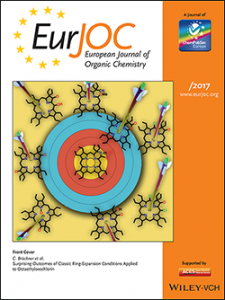Bird eggshells just became more colorful! For well over 100 years, only two pigments have been identified in avian eggshells: rusty-brown protoporphyrin (e.g., brown chicken eggs) and blue-green biliverdin (e.g., turquois eggs of robins). However, tinamou (chicken-like forest dwellers of South America) eggshells display unusually colored eggshells, suggesting the presence of other pigments. The Brückner group, in collaboration with the ornithologists and eggshell and bird color experts Daniel Hanley (Long Island University) and Richard Prum (Yale University), investigated this. Through extraction, derivatization, spectroscopy, chromatography, and mass spectrometry, they identified two novel eggshell pigments: yellow–brown bilirubin and red–orange uroerythrin from the guacamole-green and purplish-brown eggshells of two tinamous species. Both pigments are known porphyrin catabolites and were found in the eggshells in conjunction with biliverdin. A colour mixing model using the new pigments and biliverdin reproduced the respective eggshell colours. These discoveries expand our understanding of how eggshell colour diversity is achieved. The ability of these pigments to photo-degrade may have an adaptive value for the tinamous – this is the subject of follow-up studies for the ornithologists.
Eggshells and Hedgehogs
Congratulations to Randy Hamchand who defended his MS Thesis with an entirely new topic for our group: The extraction of naturally occurring porphyrins/oligopyrroles in eggshells and the quills of hedgehogs. Randy will be joining the Yale graduate program in chemistry!
Congratulations Drs. Sharma and Li!
Congratulations to Meenakshi Sharma and Ruoshi Li who successfully defended their dissertations! Dr. Li tackled the modification of octaethylporphyrin, while Dr. Sharma studied a number of oxygen-based pyrrole-modified porphyrins!
Congratulations Dr. Luciano!
Mike successfully defended his thesis, and Dr. Luciano is now to a postdoctoral position at the NIH! Congratulations Mike! We will miss you in our labs!

3-Part Series in Eur. J. Org. Chem. is out!
The 3-part series of papers study on the ring expansion reactions of the octaethyloxochlorins “Surprising Outcomes of Classic Ring Expansion Conditions Applied to Octaethyloxochlorin” is out (Part 1. Baeyer-Villiger Oxidation Conditions’ Eur. J. Org. Chem. 2017, 1820–1825. Part 2. Beckmann Rearrangement Conditions. Eur. J. Org. Chem. 2017, 1826–1834, and Part 3. Schmidt Reaction Conditions). All contributions were led by Ruoshi Li, the crystal structures were provided by Matt Zeller, and the Part 2 is the full paper of the work began by Eileen Meehan. The series was also highlighted by a cover page. We learn from this work that hardly anything goes as planned in porphyrin chemistry!

Morpholinobacteriochlorins will brighten JACS
A collaborative paper between the Birge, Gascon, and our group, led by Matthew Guberman-Pfeffer, reporting on a novel and unique mechanism to red-shift bacteriochlorin chromophores was accepted for publication as a full paper in the J. Am. Chem. Soc.!
Mending and Breaking Manuscript Published in Chem. Commun.
While our ‘breaking and mending’ of porphyrin strategy proved versatile over the last decade in the generation of a range of pyrrole-modified porphyrins containing 4-, 5-, and 6-membered heterocycles, it failed to access systems incorporating larger rings. A reversal of the strategy – first mending, then breaking – now allowed the formation of a pyrrole-modified porphyrin containing an 8‑membered 1,3,6-triazocine-2,4,8-trione heterocycle. Mike Luciano and Wes Tardie continue working on the generalization of this strategy.
Luciano, M.; Tardie, W.; Zeller, M.; Brückner, C. ‘Supersizing Pyrrole-modified Porphyrins by Reversal of the ‘Breaking and Mending’ Strategy’ Chem. Commun. 2016, 52, 10133-10136.
Porphyrin Ozonation Paper Published!
Congratulations, Meenakshi’s and Eileen’s paper on the ozonation of octaalkylporphyrins was published in Chem.–Eur. J.!
Sharma, M.; Meehan, E.; Mercado, B. Q.; Brückner, C. ‘Oxazolochlorins 16. b‑Alkyloxazolochlorins: Revisiting the Ozonation of Octaalkylporphyrins, and Beyond’ Chem.–Eur. J. 2016, 22, 11706–11718.
Journal of Organic Chemistry Manuscript Accepted
Syntheses and optical properties of mono- and bis-chromene-annulated meso-arylbacteriochlorins are described. Bacteriochlorins are red and NIR light absorbing chromophores of potential utility in synthetic light harvesting and biomedical applications as photochemotherapeutics or labelling dyes. The report expands the body of work on the optical fine-tuning of synthetic meso-aryl-substituted bacteriochlorins through intramolecular annulation reactions. The regiochemical outcomes of these annulation reactions were investigated using computational tools. (Hyland, M. A.; Hewage, N.; Panther, K.; Nimthong-Roldán, A.; Zeller, M.; Samaraweera, M.; Gascón, J. A.; Brückner, C. ‘Chromene-annulated Bacteriochlorins’ J. Org. Chem. 2016, accepted for publication 4/14/2016)
Accounts of Chemical Research paper accepted for publication
Over the past 15 years, our group developed the ‘Breaking and Mending’ strategy of converting porphyrins to porphyrin analogs containing non-pyrrolic building blocks, and this work has become the mainstay of our current work. In the Accounts of Chemical Research paper (Brückner, C. ‘The Breaking and Mending of meso-Tetraarylporphyrins: Transmuting the Pyrrolic Building Blocks’ Acc. Chem. Res. 2016, 49, 1080−1092.), the strategy was summarized and diversity of structures accessible is highlighted. An artistic representation of the concept is gracing the issue No 6 of the Accounts!